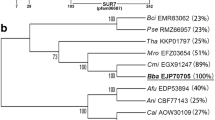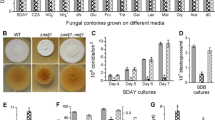Abstract
Ecm33 is one of several glycosylphosphatidylinositol (GPI)-anchored proteins. This protein is known to be involved in fungal cell wall integrity, but its contribution to multi-stress tolerance is largely unknown. Here we characterized the functions of two Ecm33 orthologues, i.e., Bbecm33 in Beauveria bassiana and Mrecm33 in Metarhizium robertsii. Bbecm33 and Mrecm33 were both confirmed as GPI-anchored cell wall proteins in immunogold localization. Single-gene disruptions of Bbecm33 and Mrecm33 caused slight growth defects, but conidial yield decreased much more in ΔBbecm33 (76 %) than in ΔMrecm33 (42 %), accompanied with significant reductions of intracellular mannitol and trehalose contents in both mutants and weakened cell walls in ΔBbecm33 only. Consequently, ΔBbecm33 was far more sensitive to the cell wall-perturbating agents Congo red and sodium dodecyl sulfate (SDS) than ΔMrecm33, which showed null response to SDS. Both deletion mutants became significantly more sensitive to two oxidants (menadione and H2O2), two fungicides (carbendazim and ethirimol), osmotic salt NaCl, and Ca2+ during growth despite some degrees of differences in their sensitivities to the chemical stressors. Strikingly, conidial UV-B resistance decreased by 55 % in ΔBbecm33 but was unaffected in ΔMrecm33, unlike a similar decrease (25–28 %) of conidial thermotolerance in both. All the changes were restored to wild-type levels by gene complementation through ectopic gene integration in each fungus. However, neither ΔBbecm33 nor ΔMrecm33 showed a significant change in virulence to a susceptible insect host. Our results indicate that Bbecm33 and Mrecm33 contribute differentially to the conidiation and multi-stress tolerance of B. bassiana and M. robertsii.




Similar content being viewed by others
References
Bischoff JF, Rehner SA, Humber RA (2009) A multilocus phylogeny of the Metarhizium anisopliae lineage. Mycologia 101:512–530
Bruneau JM, Magnin T, Tagat E, Legrand R, Bernard M, Diaquin M, Fudali C, Latgé JP (2001) Proteome analysis of Aspergillus fumigatus identifies glycosylphosphatidylinositol-anchored proteins associated to the cell wall biosynthesis. Electrophoresis 22:2812–2823
Caro LH, Tettelin H, Vossen JH, Ram AF, van den Ende H, Klis FM (1997) In silicio identification of glycosyl-phosphatidylinositol-anchored plasma-membrane and cell wall proteins of Saccharomyces cerevisiae. Yeast 13:1477–1489
Castro Nda S, Maia ZA, Pereira M, Soares CM (2005) Screening for glycosylphosphatidylinositol-anchored proteins in the Paracoccidioides brasiliensis transcriptome. Genet Mol Res 4:326–345
Chabane S, Sarfati J, Ibrahim-Granet O, Du C, Schmidt C, Mouyna I, Prevost MC, Calderone R, Latgé JP (2006) Glycosylphosphatidylinositol-anchored Ecm33p influences conidial cell wall biosynthesis in Aspergillus fumigatus. Appl Environ Microbiol 72:3259–3267
Chen Y, Zhu J, Ying SH, Feng MG (2014) Three mitogen-activated protein kinases required for cell wall integrity contribute greatly to biocontrol potential of a fungal entomopathogen. PLos ONE 9:e87948. doi:10.1371/journal.pone.0087948
Cid VJ, Durán A, del Rey F, Snyder MP, Nombela C, Sánchez M (1995) Molecular basis of cell integrity and morphogenesis in Saccharomyces cerevisiae. Microbiol Rev 59:345–386
Doehlemann G, Berndt P, Hahn M (2006) Trehalose metabolism is important for heat stress tolerance and spore germination of Botrytis cinerea. Microbiology UK 152:2625–2634
Elbein AD, Pan YT, Pastuszak I, Carroll D (2003) New insights on trehalose: a multifunctional molecule. Glycobiology 13:17R–27R
Fang WG, Zhang YJ, Yang XY, Zheng X, Duan H, Li Y, Pei Y (2004) Agrobacterium tumefaciens-mediated transformation of Beauveria bassiana using an herbicide resistance gene as a selection marks. J Invertebr Pathol 85:18–24
Frieman MB, Cormack BP (2003) The ω-site sequence of glycosylphosphatidylinositol-anchored proteins in Saccharomyces cerevisiae can determine distribution between the membrane and the cell wall. Mol Microbiol 50:883–896
Gao Q, Jin K, Ying SH, Zhang Y, Xiao G, Shang Y, Duan Z, Hu X, Xie XQ, Zhou G, Peng G, Luo Z, Huang W, Wang B, Fang WG, Wang SB, Zhong Y, Ma LJ, St Leger RJ, Zhao GP, Pei Y, Feng MG, Xia YX, Wang CS (2011) Genome sequencing and comparative transcriptomics of the model entomopathogenic fungi Metarhizium anisopliae and M. acridum. PLoS Genet 7:e1001264
Hamada K, Terashima H, Arisawa M, Kitada K (1998) Amino acid sequence requirement for efficient incorporation of glycosylphosphatidylinositol-associated proteins into the cell wall of Saccharomyces cerevisiae. J Biol Chem 273:26946–26953
Hamada K, Terashima H, Arisawa M, Yabuki N, Kitada K (1999) Amino acid residues in the ω-minus region participate in cellular localization of yeast glycosylphosphatidylinositol-attached proteins. J Bacteriol 181:3886–3889
Huang BF, Feng MG (2009) Comparative tolerance of various Beauveria bassiana isolates to UV-B irradiation with a description of a modeling method to assess lethal dose. Mycopathologia 168:145–152
Jaiseng W, Fang Y, Ma Y, Sugiura R, Kuno T (2012) Studies on the roles of clathrin-mediated membrane trafficking and zinc transporter Cis4 in the transport of GPI-anchored proteins in fission yeast. PLoS ONE 7:e41946
Kapteyn JC, Van Den Ende H, Klis FM (1999) The contribution of cell wall proteins to the organization of the yeast cell wall. Biochim Biophys Acta 1426:373–383
Lesage G, Bussey H (2006) Cell wall assembly in Saccharomyces cerevisiae. Microbiol Mol Biol Rev 70:317–343
Levdansky E, Kashi O, Sharon H, Shadkchan Y, Osherov N (2010) The Aspergillus fumigatus cspA gene encoding a repeat-rich cell wall protein is important for normal conidial cell wall architecture and interaction with host cells. Eukaryot Cell 9:1403–1415
Li J, Feng MG (2009) Intraspecific tolerance of Metarhizium anisopliae conidia to the upper thermal limits of summer with a description of a quantitative assay system. Mycol Res 113:93–99
Li J, Ying SH, Shan LT, Feng MG (2010) A new non-hydrophobic cell wall protein (CWP10) of Metarhizium anisopliae enhances conidial hydrophobicity when expressed in Beauveria bassiana. Appl Microbiol Biotechnol 85:975–984
Liu Q, Ying SH, Feng MG, Jiang XH (2009) Physiological implication of intracellular trehalose and mannitol changes in response of entomopathogenic fungus Beauveria bassiana to thermal stress. Antonie Van Leeuwenhoek 95:65–75
Livak KJ, Schmittgen TD (2001) Analysis of relative gene expression data using real-time quantitative PCR and the 2−ΔΔC T method. Methods 25:402–408
Luo XD, Keyhani NO, Yu XD, He ZJ, Luo ZB, Pei Y, Zhang YJ (2012) The MAP kinase Bbslt2 controls growth, conidiation, cell wall integrity, and virulence in the insect pathogenic fungus Beauveria bassiana. Fungal Genet Biol 49:544–555
Martínez-López R, Monteoliva L, Diez-Orejas R, Nombela C, Gil C (2004) The GPI-anchored protein CaEcm33 is required for cell wall integrity, morphogenesis and virulence in Candida albicans. Microbiology SGM 150:3341–3354
Martínez-López R, Park H, Myers CL, Gil C, Filler SG (2006) Candida albicans Ecm33p is important for normal cell wall architecture and interactions with host cells. Eukaryot Cell 5:140–147
Martínez-López R, Nombela C, Diez-Orejas R, Monteoliva L, Gil C (2008) Immunoproteomic analysis of the protective response obtained from vaccination with Candida albicans ecm33 cell wall mutant in mice. Proteomics 8:2651–2664
Mouyna I, Fontaine T, Vai M, Monod M, Fonzi WA, Diaquin M, Popolo L, Hartland RP, Latgé JP (2000) Glycosylphosphatidylinositol-anchored glucanosyltransferases play an active role in the biosynthesis of the fungal cell wall. J Biol Chem 275:14882–14889
Pardo M, Monteoliva L, Vázquez P, Martínez R, Molero G, Nombela C, Gil C (2004) PST1 and ECM33 encode two yeast cell surface GPI proteins important for cell wall integrity. Microbiology SGM 150:4157–4170
Percival-Smith A, Segall J (1987) Increased copy number of the 5′ end of the SPS2 gene inhibits sporulation of Saccharomyces cerevisiae. Mol Cell Biol 7:2484–2490
Rangel DE, Anderson AJ, Roberts DW (2008) Evaluating physical and nutritional stress during mycelia growth as inducers of tolerance to heat and UV-B radiation in Metarhizium anisopliae conidia. Mycol Res 112:1362–1372
Rispail N, Soanes DM, Ant C, Czajkowski R, Grünler A, Huguet R, Perez-Nadales E, Poli A, Sartorel E, Valiante V, Yang M, Beffa R, Brakhage AA, Gow NAR, Kahmann R, Lebrun MH, Lenasi H, Perez-Martin J, Talbot NJ, Wendland J, Di Pietro A (2009) Comparative genomics of MAP kinase and calcium-calcineurin signaling components in plant and human pathogenic fungi. Fungal Genet Biol 46:287–298
Roberts DW, St Leger RJ (2004) Metarhizium spp., cosmopolitan insect pathogenic fungi: mycological aspects. Adv Appl Microbiol 54:1–70
Romano J, Nimrod G, Ben-Tal N, Shadkchan Y, Baruch K, Sharon H, Osherov N (2006) Disruption of the Aspergillus fumigatus ECM33 homologue results in rapid conidial germination, antifungal resistance and hypervirulence. Microbiology SGM 152:1919–1928
Takada H, Nishida A, Domae M, Kita A, Yamano Y, Uchida A, Ishiwata S, Fang Y, Zhou X, Masuko T, Kinoshita M, Kakehi K, Sugiura R (2010) The cell surface protein gene ecm33 + is a target of the two transcription factors Atf1 and Mbx1 and negatively regulates Pmk1 MAPK cell integrity signaling in fission yeast. Mol Biol Cell 21:674–685
Tamura K, Peterson D, Peterson N, Stecher G, Nei M, Kumar S (2011) MEGA5: molecular evolutionary genetics analysis using maximum likelihood, evolutionary distance, and maximum parsimony methods. Mol Biol Evol 10:2731–2739
Terashima H, Hamada K, Kitada K (2003) The localization change of Ybr078w/Ecm33, a yeast GPI-associated protein, from the plasma membrane to the cell wall, affecting the cellular function. FEMS Microbiol Lett 218:175–180
Tohe A, Oguchi T (1999) Las21 participates in extracellular/cell surface phenomena in Saccharomyces cerevisiae. Genes Genet Syst 74:241–256
Tougan T, Chiba Y, Kakihara Y, Hirata A, Nohima H (2002) Meu10 is required for spore wall maturation in Schizosaccharomyces pombe. Genes Cells 7:217–231
Vega FE, Meyling NV, Luangsa-Ard JJ, Blackwell M (2012) Fungal entomopathogens. In: Vega F, Kaya HK (eds) Insect pathology, 2nd edn. Academic, San Diego, pp 171–220
Walker CA, Gómez BL, Mora-Montes HM, Mackenzie KS, Munro CA, Brown AJ, Gow NA, Kibbler CC, Odds FC (2010) Melanin externalization in Candida albicans depends on cell wall chitin structures. Eukaryot Cell 9:1329–1342
Wanchoo A, Lewis MW, Keyhani NO (2009) Lectin mapping reveals stage-specific display of surface carbohydrates in in vitro and haemolymph-derived cells of the entomopathogenic fungus Beauveria bassiana. Microbiology SGM 155:3123–3133
Wang CS, Feng MG (2014) Advances in fundamental and applied studies in China of fungal biocontrol agents for use against arthropod pests. Biol Control 68:129–135
Wang ZL, Lu JD, Feng MG (2012) Primary roles of two dehydrogenases in the mannitol metabolism and multi-stress tolerance of entomopathogenic fungus Beauveria bassiana. Environ Microbiol 14:2139–2150
Xiao GH, Ying SH, Zheng P, Wang ZL, Zhang SW, Xie XQ, Shang YF, Zheng HJ, Zhou Y, St Leger RJ, Zhao GP, Wang CS, Feng MG (2012) Genomic perspectives on the evolution of fungal entomopathogenicity in Beauveria bassiana. Sci Rep 2:483. doi:10.1038/srep00483
Xie XQ, Li F, Ying SH, Feng MG (2012) Additive contributions of two manganese-cored superoxide dismutases (MnSODs) to anti-oxidation, UV tolerance and virulence of Beauveria bassiana. PLoS ONE 7:e30298
Yao SL, Ying SH, Feng MG, Hatting JL (2010) In vitro and in vivo responses of fungal biocontrol agents to the gradient doses of UV-B and UV-A irradiations. BioControl 55:413–422
Yin QY, de Groot PW, Dekker HL, de Jong L, Klis FM, de Koster CG (2005) Comprehensive proteomic analysis of Saccharomyces cerevisiae cell walls: identification of proteins covalently attached via glycosylphosphatidylinositol remnants or mild alkali-sensitive linkages. J Biol Chem 280:20894–20901
Zhang YJ, Zhao JH, Fang WG, Zhang JQ, Luo ZB, Zhang M, Fan YH, Pei Y (2009) Mitogen-activated protien kinase hog1 in the entomopathogenic fungus Beauveria bassiana regulates environmental stress responses and virulence to insects. Appl Environ Microbiol 75:3787–3795
Zheng P, Xia YL, Xiao GH, Xiong CH, Zhang SW, Zheng HJ, Huang Y, Zhou Y, Wang SY, Zhao GP, Liu XZ, St Leger RJ, Wang CS (2011) Genome sequence of the insect pathogenic fungus Cordyceps militaris, a valued traditional Chinese medicine. Genome Biol 12:R116
Zhou G, Wang J, Qiu L, Feng MG (2012) A Group III histidine kinase (mhk1) upstream of high-osmolarity glycerol pathway regulates sporulation, multi-stress tolerance and virulence of Metarhizium robertsii, a fungal entomopathogen. Environ Microbiol 14:817–829
Acknowledgments
This work was financially supported by the Ministry of Science and Technology of China (Grant No.: 2011AA10A204) and the Natural Science Foundation of China (Grant Nos.: 31270537 and 3102100).
Author information
Authors and Affiliations
Corresponding author
Rights and permissions
About this article
Cite this article
Chen, Y., Zhu, J., Ying, SH. et al. The GPI-anchored protein Ecm33 is vital for conidiation, cell wall integrity, and multi-stress tolerance of two filamentous entomopathogens but not for virulence. Appl Microbiol Biotechnol 98, 5517–5529 (2014). https://doi.org/10.1007/s00253-014-5577-y
Received:
Revised:
Accepted:
Published:
Issue Date:
DOI: https://doi.org/10.1007/s00253-014-5577-y




